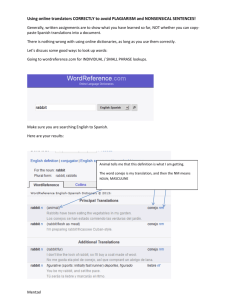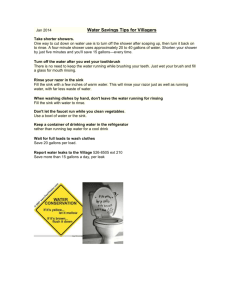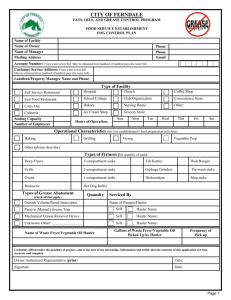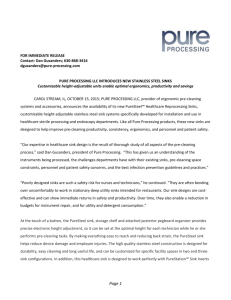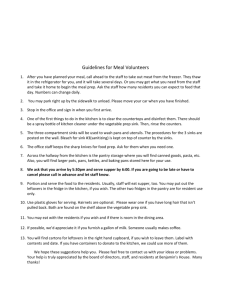Starting a Food Business - Defiance County General Health District
advertisement
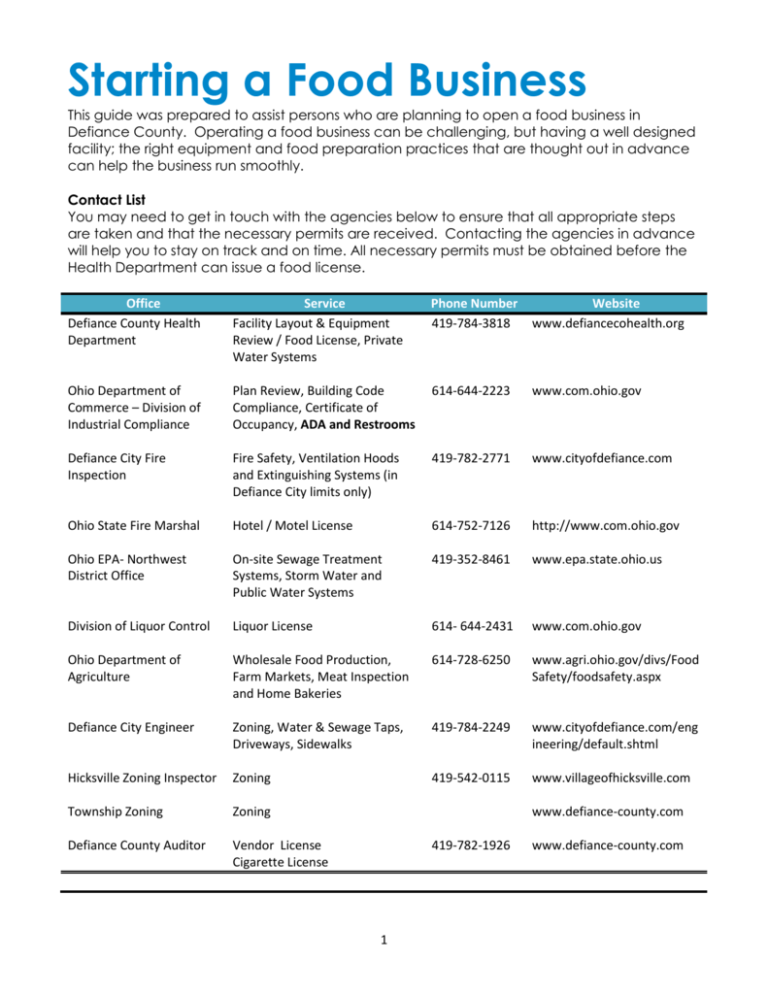
Starting a Food Business This guide was prepared to assist persons who are planning to open a food business in Defiance County. Operating a food business can be challenging, but having a well designed facility; the right equipment and food preparation practices that are thought out in advance can help the business run smoothly. Contact List You may need to get in touch with the agencies below to ensure that all appropriate steps are taken and that the necessary permits are received. Contacting the agencies in advance will help you to stay on track and on time. All necessary permits must be obtained before the Health Department can issue a food license. Office Defiance County Health Department Service Facility Layout & Equipment Review / Food License, Private Water Systems Phone Number 419-784-3818 Website www.defiancecohealth.org Ohio Department of Commerce – Division of Industrial Compliance Plan Review, Building Code Compliance, Certificate of Occupancy, ADA and Restrooms 614-644-2223 www.com.ohio.gov Defiance City Fire Inspection Fire Safety, Ventilation Hoods and Extinguishing Systems (in Defiance City limits only) 419-782-2771 www.cityofdefiance.com Ohio State Fire Marshal Hotel / Motel License 614-752-7126 http://www.com.ohio.gov Ohio EPA- Northwest District Office On-site Sewage Treatment Systems, Storm Water and Public Water Systems 419-352-8461 www.epa.state.ohio.us Division of Liquor Control Liquor License 614- 644-2431 www.com.ohio.gov Ohio Department of Agriculture Wholesale Food Production, Farm Markets, Meat Inspection and Home Bakeries 614-728-6250 www.agri.ohio.gov/divs/Food Safety/foodsafety.aspx Defiance City Engineer Zoning, Water & Sewage Taps, Driveways, Sidewalks 419-784-2249 www.cityofdefiance.com/eng ineering/default.shtml Hicksville Zoning Inspector Zoning 419-542-0115 www.villageofhicksville.com Township Zoning Zoning Defiance County Auditor Vendor License Cigarette License www.defiance-county.com 419-782-1926 1 www.defiance-county.com Where do I begin? Nearly every facility serving or selling food in Defiance County will need a Food License. The road to receiving a Food License begins with a Facility Layout and Equipment Review. The Operator must submit: 1. a menu or list of foods to be served or sold, 2. a detailed floor plan drawn to scale, 3. an equipment list with make and model numbers, 4. a surface finish schedule, 5. a lighting plan, 6. a plumbing plan, 7. an application and 8. the appropriate fee. A sanitarian will review the plans in order to ensure that the equipment, facilities and design will be adequate for the food items served or sold at the facility. This guide will help you to determine when you need to submit plans, who you need to get in contact with, and what to expect as far as process and timeline. PLANNING AHEAD What is required in my facility? Every business is unique. What will be required will be based on your menu. So, you must make sure that you have the space and equipment needed to store, prepare and serve those foods safely. Many retail stores will not need the extent of facilities and equipment that a restaurant would need, just as small operations may not need as much equipment that a larger operation would require. EQUIPMENT YOU WILL NEED…. (AND OTHER ITEMS) Hand washing sinks: All facilities are required to have adequate employee hand washing sinks, conveniently located in each food and dishwashing area, and equipped with soap and disposable towels or hand dryers. Convenient location means that the sink is accessible and visible from any food area, including bars and ice dispensing locations such as wait stations. It must be no more than twenty-five (25) feet walking distance and may not be separated by a door (i.e. inside an employee restroom). These sinks are required to have signs reminding employees to wash hands. Exception: In facilities that serve only prepackaged foods, a hand sink is only required in a restroom. HELPFUL TIP: Each sink described in this section can only be used for its designated purpose (hand washing, dishwashing, food prep, mop sink). Dishwashing sinks: A 3-compartment sink designated for dishwashing is required in any operation using dishes or utensils. The sink must be constructed of approved materials (stainless), have curved interior edges and at least three (3) compartments for washing, rinsing and sanitizing. The sink must also have two (2) drainboards, one for collection of dirty dishes and the other for air drying. Garbage disposers may not be installed on dishwashing sinks. Commercial dishwashers are optional, but a 3-compartment sink is required in a facility using dishes or utensils. Each compartment of the sink must be large enough to submerge the 2 largest piece of equipment you have (i.e. a small bar sink would not be acceptable for washing large pots and pans). Chemical sanitizing dishwashers must have visual or audible methods to monitor chemical injection. High temperature dish machines must provide final rinse water at 180F. HELPFUL TIP: Locate water heaters near dishwashing facilities to minimize lag cycles and temperature losses. HELPFUL TIP:A If you have a steam table, a 4-compartment sink will allow presoaking of pans. Food processing sink (vegetable sink): Rules does not allow food processing in a hand sink or dishwashing sink. A separate sink is required for the processing of produce and other foods. Processing can include washing, soaking, thawing, and using ice baths for cooling. If a food processing sink is not available, a facility will be limited to using only prewashed produce. A food prep sink must have an indirect drain, specifically an air gap, to prevent backflow from a sewage system into equipment in which food is placed. The air gap should be twice the diameter of the pipe, but no less than one inch. HELPFUL TIP: Installing a food sink with an integral drainboard will provide you with a food prep surface for items washed in the sink. Utility sink: Also called a mop sink or service sink, all facilities are required to have a sink designated for cleaning of mops and cleaning tools, and for disposal of mop water. The utility sink must include a faucet and drain. This sink should have hooks or other means to allow mops to air dry. Utility sinks must be located on the same floor as the food preparation area, not in a basement. HELPFUL TIP: A curbed sink provides an easier means to dump mop water, and is a good storage spot for the mop bucket when not in use. Commercial equipment: All equipment used for a retail food operation must be listed as commercial and must be certified by a recognized testing agency (e.g. NSF, ETL, UL-S). No household equipment is permitted. Casters are required for large equipment if it is not already on legs or permanently fixed (caulked) to the floor with space for cleaning. HELPFUL TIP: Check the label on the equipment or request a specification sheet from the vendor before purchasing. Request casters for larger pieces, such as refrigeration units, to make them easier to move for cleaning. Dry storage space: Adequate space must be planned for storage of food, dishes, and equipment. Ensure that there are designated locations for bulk foods, cans, and other items. All food items must be stored at least 6” off the floor, both in walk-in coolers or freezers, and on storage shelving. Metal office shelving and raw wood shelves are not acceptable. Look for wire racks and food grade shelving. Equipment and single service items (e.g. ‘to go’containers) must be protected from contamination and stored at least 6” off the floor. HELPFUL TIP: Bins for bulk items (e.g. rice, flour) must be made of food grade material and marked with the type of food inside. Trash cans and non-food grade containers cannot be used for bulk food storage. Chemical storage: Chemicals must be stored below and/or away from food items, equipment and utensils to prevent contamination of these items. Chemicals cannot be stored above the dishwashing sink or on the floor. 3 Employee area: There must be lockers, shelving or a designated area provided only for employee belongings. Personal belongings such as coats, purses, cigarettes, and phones cannot be kept in food areas. HELPFUL TIP: The employee area is also a great location for storage of employee beverage cups or food. Adequate lighting: Lighting must be sufficient in food areas and other areas to allow for safe work conditions and to facilitate cleaning. A guide to general lighting intensity requirements are listed below. 50 footcandles: cooking areas, food prep areas, food service areas 20 footcandles: surfaces for customer self service and buffet tables, inside equipment (reach in cooler). 20 footcandles 30 inches above floor in areas used for hand washing, dishwashing, utensil storage and restrooms. 10 footcandles: 30 inches above the floor in walk-in coolers and freezers, dry storage, and other areas HELPFUL TIP: When submitting a lighting plan for plan review, it should include (1) type of fixtures, (2) location of fixtures, and (3) whether using plastic covers, shields, or shatterproof bulbs to protect food & equipment. Smooth and cleanable surfaces: All floors, walls and ceilings in food areas (service, storage or preparation) must be smooth and easily cleanable. Carpet is acceptable only in areas for packaged food storage. Acceptable surfaces which are commonly used… Floors: quarry tile, commercial grade VCT, ceramic tile, sealed concrete, poured epoxy. Walls: stainless steel, FRP, glossy painted drywall, painted concrete block Ceilings: vinyl coated ACT (drop ceiling), glossy painted drywall Base Coving: tile, rubber Walls and floors in areas with high heat equipment like grills and deep fryers need to be nonflammable and heat resistant like aluminum, stainless, quarry tile, etc. HELPFUL TIP: Every facility must submit a finish schedule with plan review. Based on your menu and equipment that is used, many facilities will also need… Ventilation hoods: A ventilation hood is required at a grill line, or where other cooking equipment and high temperature dish machines are located, to prevent the accumulation of grease, heat, condensation, smoke and vapors. Installation of a ventilation hood requires a permit and inspections. Contact Division of Industrial Compliance (phone numbers on page 1) with questions about ventilation requirements or permits for installation. HELPFUL TIP: Ventilation is always required for gas equipment. Fire suppression system: If a ventilation hood is required because of the use of grease producing equipment (fryers, grill, etc), a Type I Hood with fire suppression is required. The fire suppression system acts like a fire extinguisher in case of a grease or cooking fire. If a hood is required for heat, condensation or gas only, a Type II Hood might be acceptable. Verify the type of hood required through Division of Industrial Compliance. Grease interceptor (grease trap): A grease trap is a device that is attached to sinks and/or drains to collect fats, oils and grease in order to prevent accumulation in our sewer system. Grease traps are connected to dishwashing sinks, some floor drains (e.g. at wok lines) and some dishwashers. 4 Grease traps are not a requirement of Division of Industrial Compliance. HELPFUL TIP: A grease trap can be a costly installation, and is generally required when a dishwashing sink is used. Make sure to research and budget for this item in your planning stages. HELPFUL TIP: Grease traps must be cleaned periodically to keep them working properly. An indoor grease trap may need to be cleaned monthly/quarterly, while a larger outdoor unit may only need cleaning once or twice per year. RUNNING YOUR BUSINESS… (WITH FOOD SAFETY IN MIND) Here are some important questions about how you will safely prepare food for your business. Employee Training… How will you train your staff about food safety? What food safety practices will be covered during staff orientation? What is your employee health policy? What do you do about a sick worker? How will you share this policy with employees? Services… Who will provide your waste pickup? How will you handle grease waste and cleaning your grease interceptor? Do you have a certified pest control operator? Who will clean your hood system and/or fire suppression system? Who will provide support and maintenance for your dishwasher? Is your facility secure, and is your food supply safe? Do you make sure to use approved suppliers? Does your food come from approved sources? Facilities… Do you have enough hot water capacity for the busiest time of day? Do you have the storage space needed for dry goods? Do you plan to expand the operation, and will you have the space? Are floors, walls and ceilings constructed with cleanable materials? Equipment… Do you have enough space in your coolers and freezers? Can you prevent overstocking and make certain to allow for air circulation? How will you keep hot foods hot? How will you keep cold foods cold? Have you purchased thermometers for all coolers? Do you have thermometers for taking food temperatures? Plan for Easy Cleaning... There are several things you can do to prevent the amount of future maintenance necessary for your facility and provide ease of cleaning. Have you considered stainless steel on walls at the grill line, and behind and around grease producing equipment? Have you placed heavy equipment on casters, so that it can be moved easily? Every other piece of equipment, especially at the grill line, should be on casters. This makes it easier to clean behind and between equipment. Can you avoid sealing equipment and sinks to walls, and instead brace and set equipment away from walls and other equipment? This makes it easier to clean behind 3 compartment sinks, dishwashers, etc. Set equipment at least 4 inches from the wall. r cleaning. 5 Fixed Equipment… Is all equipment that is fixed (because it is not easily movable) installed to allow for easy cleaning? This means that it must be spaced from adjoining equipment or sealed to adjoining walls or equipment. Is table mounted equipment that is not easily moveable on legs or sealed to a table? Is all floor mounted equipment (in kitchen areas) that is not easily movable sealed to the floor or elevated on 6 inch legs? Processes… What will be your process for date marking ready-to-eat food products? How will you ensure that a ‘first in, first out’ system is used for foods? How will foods be properly thawed? Do you have enough cooler space to allow for overnight thawing? Can large amounts of leftover food be properly cooled? Do you have shallow pans, ice wands, or other necessary tools? Will you keep temperature logs? Who will be responsible? When will you take temperatures? How will you avoid bare hand contact with ready to eat foods? Will you use gloves, tongs, utensils, deli paper, or other tools? FOOD SAFETY TRAINING As of March 1, 2010 the Ohio Revised Code requires that at least one person in charge per shift of a food service operation or retail food establishment must have attended an Ohio Department of Health approved Level One Certification in Food Protection course or an equivalent approved training prior to the business being licensed. See full listing of providers including web based courses at: http://www.odh.ohio.gov/odhPrograms/eh/foods/cert.aspx Educating your employees is an important part of planning for a successful food business. The Ohio Uniform Food Code requires that a Person-in-Charge (PIC) be present during all hours of operation of a food business. The PIC must understand basic food safety concepts, and will need to demonstrate knowledge by compliance with the food code. This person must make sure that safe food handling practices are followed to lower the risk of foodborne illness. The Ohio State University Extension provides food safety classes that will assist in educating your employees. They provide a Level one course (4 hours) which reviews the basics of food safety and requirements of the Ohio Uniform Food Code. They also provide the nationally recognized ServSafe® course (Level two) (16 hours), recommended for all managers. Call or e-mail Cheryl Spires at 419-337-9210 or spires.53@osu.edu Nancy Stehulak at 419-592-0806 or stehulak.1@osu.edu STEPS TO OPENING YOUR BUSINESS Defiance County Health Department reviews facility plans to make sure that the design and equipment in a facility are adequate for the storage, preparation and service of the foods on the proposed menu or food list. Step 1: PLAN REVIEW Who must submit plans? New facilities: New construction and facilities that have never been licensed as a food operation in the past. 6 Remodeled or altered facilities: Major changes or alterations such as installation of a walk in cooler or ventilation hood, or expanding a kitchen. Change of business: Changes in layout or equipment (example: a new owner converts a bakery into a full service restaurant, and grills and ovens have been added to the kitchen). What is the process? After your set of plans, application and payment for plan review has been received by the department we will begin reviewing the plans. The department has up to 30 days to begin the review, but we will do our best to follow your schedule for opening. If there are any questions about the plans, or changes that need to be discussed, we will contact you (generally by phone or e-mail). When plans are approved, an approval letter will be mailed to the Plan Review Contact noted on the application. Step 2: LICENSING After plans have been approved and all work is complete, you will need to contact the department for a pre-opening inspection. The inspection can be conducted once you have all the required ‘sign-offs’ from the appropriate city departments (Newly constructed facilities will need to have final approval from Division of Industrial Compliance before a license can be issued.), and at least one person in charge per shift of the facility must have attended the level one training or an equivalent approved training. If the facility is found to be in substantial compliance the operation is licensed and approved to operate. The printed license will be sent to you in the mail. License renewal is due once a year, and payment for licenses must be received by March 1 every year. Late fees are assessed after March 1. Licenses issued on or after December 1 must be renewed by a year from March. Check the expiration date on the license if you are unsure. 7

